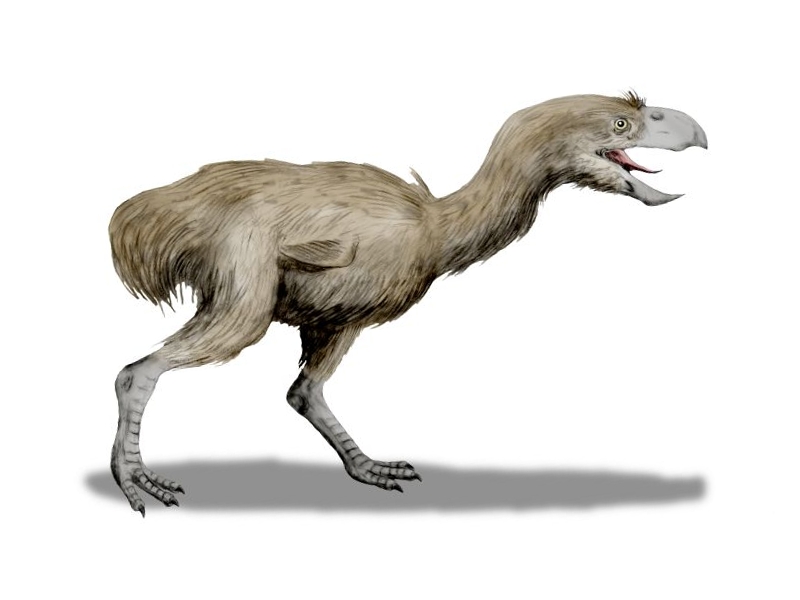- Phorusrhacidae
Taxobox
name = Phorusrhacids
fossil_range = Fossil range|62|2Middle Paleocene -Late Pliocene

image_width = 240px
image_caption = "Paraphysornis ".
regnum =Animalia
phylum =Chordata
classis =Aves
ordo =Gruiformes
familia = Phorusrhacidae
familia_authority = Ameghino, 1889cite journal |last=Ameghino |first=F |authorlink= |coauthors= |year=1889 |month= |title=Contribuición al conocimiento de los mamíferos fósiles de la República Argentina |journal=Actas Academia Nacional Ciencias de Córdoba |volume=6 |issue= |pages=1–1028 |id= |url= |accessdate= |quote= | language = Spanish ]
synonyms ="see text"Phorusrhacids ("Rag-Bearers"), or terror birds, were a family of large
carnivorous flightless bird s that were the dominantpredator s inSouth America during theCenozoic , 62–2 million years (Ma) ago. They were roughly 1–3 meters (3–10 feet) tall. Their closest modern-day relatives are believed to be the 0.8 m-tallseriema s. "Titanis walleri ", one of the larger species, is known from Texas and Florida inNorth America . This makes the phorusrhacids the only known example of large South American predators migrating north during theGreat American Interchange (which occurred after the volcanicIsthmus of Panama ", 35(2): 123-126. doi|10.1130/G23186A.1 [http://www.gsajournals.org/perlserv/?request=res-loc&uri=urn%3Aap%3Apdf%3Adoi%3A10.1130%2FG23186A.1 PDF fulltext] ]A recently discovered species, "Kelenken guillermoi" from Middle
Miocene some 15 million years ago, discovered inPatagonia in 2006 represents the largest birdskull yet found. The fossil has been described as being a 28-inch (71 cm), nearly intact skull. The beak is roughly convert|18|in|mm long and curves in a hook shape that resembles an eagle's beak. It is thought that this new species would easily be able to swallow dog-sized prey. Most species described as Phorusrhacidae birds were smaller, 2 to 3 feet (0.6 - 0.9m) tall, but the new fossil belongs to a bird that probably stood about convert|10|ft|m tall (3 m). Although scientists cannot be sure, they predict that the large terror birds were extremely nimble and quick runners able to reach speeds of convert|30|mi/h|km/h|abbr=on. [Anitei, Stefan, "The Largest Terror Bird - It had the largest bird skull" [http://news.softpedia.com/news/The-Largest-Terror-Bird-38936.shtml] ]Phorusrhacids are colloquially known as "terror birds", because their larger species were apex
predator s and the most fearsomecarnivores of their habitat (before, during and after the arrival ofsaber-toothed cats 2.5 Ma ago). Their wings had evolved into meathook-like structures that likely could be stretched out like arms to perform a hacking motion which theoretically would help in bringing down prey. Most of the smaller and some of the larger species are believed to have been fast runners.ystematics and taxonomy
Following the revision by Alvarenga and Höfling (2003), there are now 5 subfamilies, containing 14 genera and 18
species :cite journal |last=Alvarenga |first=Herculano M.F. |authorlink= |coauthors=Höfling, Elizabeth |year=2003 |month= |title=Systematic revision of the Phorusrhacidae (Aves: Ralliformes) |journal=Papéis Avulsos de Zoologia |volume=43 |issue=4 |pages=55–91 |id= |url=http://www.scielo.br/scielo.php?script=sci_pdf&pid=S0031-10492003000400001&lng=en&nrm=iso&tlng=en |accessdate= |quote= ]* Subfamily Brontornithinae — gigantic species, standing over convert|2|m|ft high. Placement in Phorusrhacidae and/or monophyly disputed.
** Genus "Brontornis " (Early - Middle Miocene)
** Genus "Paraphysornis " (Late Oligocene/Early Miocene of São Paulo State, Brazil)
** Genus "Physornis " (Middle - Late Oligocene of Santa Cruz Province, Argentina)
* Subfamily Phorusrhacinae — gigantic species convert|3|m|ft high, but somewhat smaller and decidedly more nimble than the Brontornithinae
** Genus "Devincenzia " (LateMiocene - EarlyPliocene of NEArgentina and Arroyo Roman,Uruguay )
** Genus "Kelenken " (MiddleMiocene of Río Negro province,Argentina (largest known phorusrhacid))
** Genus "Phorusrhacos " (Early - Middle Miocene )
** Genus "Titanis " (Early - Late Pliocene)
* Subfamily Patagornithinae — medium-sized and very nimble species, standing around convert|1.5|m|ft high
** Genus "Patagornis " (Santa Cruz Early - Middle Miocene of Santa Cruz Province, Argentina) - includes "Morenomerceraria"Verify source|date=November 2007 , "Palaeociconia", "Tolmodus"
** Genus "Andrewsornis " (Middle - Late Oligocene of S Argentina)
** Genus "Andalgalornis " (Late Miocene - Early Pliocene)
* Subfamily Psilopterinae — small species, standing convert|70|-|100|cm|ft high
** Genus "Psilopterus " (Deseado Middle Oligocene - Arroyo Chasicó Late Miocene of S and E Argentina)
** Genus "Procariama " (Late Miocene - Early Pliocene of Catamarca Province, Argentina)
** Genus "Paleopsilopterus " (Middle Paleocene of Itaboraí, Brazil)
* Subfamily Mesembriornithinae — medium-sized species, standing between 1 and 1.5 m high
** Genus "Mesembriornis " (Late Miocene - Late Pliocene)Alvarenga and Höfling do not include the
Sophiornithidae from Europe in the phorusrhacoids; these have meanwhile turned out to be primitive relatives ofowl s.cite journal |last=Mayr |first=Gerald |authorlink= |coauthors= |year= 2005-04-15 |title=Old World phorusrhacids (Aves, Phorusrhacidae): a new look at "Strigogyps" ("Aenigmavis") "sapea" (Peters 1987) |journal=PaleoBios |volume=25 |issue=1 |pages=11–16 |id= |url=http://www.ucmp.berkeley.edu/science/paleobios/abstracts_21to25.php |accessdate=2008-07-04 |quote=|format=abstract ]ynonyms
The family Phorusrhacidae have been described under a number of synonyms:
* Phororhacosidae Ameghino, 1889
* Pelecyornidae Ameghino, 1891
* Brontornithidae Moreno & Mercerat, 1891
* Darwinornithidae Moreno & Mercerat, 1891
* Stereornithidae Moreno & Mercerat, 1891
* Phororhacidae Lydekker, 1893 (unjustified emendation)
* Patagornithidae Mercerat, 1897
* Hermosiornidae Rovereto, 1914
* Psilopteridae Dolgopol de Saez, 1927
* Devincenziidae Kraglievich, 1932
* Hermosiorniidae Kraglievich, 1932 (unjustified emendation)
* Mesembriorniidae Kraglievich, 1932
* Hermosiornithidae Wetmore, 1934 (unjustified emendation)Popular culture
While not as widespread as
dinosaur s, phorusrhacids are popular in various forms of fiction. Terror birds are featured inRobert E. Howard 's 1931 short story "The Gods of Bal-Sagoth", in the 2008 film "10,000 BC", in the 2001 multi-player online role-playing gameRuneScape , and in the 2006 documentary-style mini-series "Prehistoric Park ". "Phorusrhacos " also appears in episode 5 of the 2001BBC documentaryWalking With Beasts .References
Further reading
*cite journal |last=Bertelli |first=Sara |authorlink= |coauthors=Chiappe, Luis M; Tambussi, Claudia |year=2007 |month= |title=A New Phorusrhacid (Aves: Cariamae) from the Middle Miocene of Patagonia, Argentina |journal=Journal of Vertebrate Paleontology |volume=27 |issue=2 |pages=409–419 |doi=10.1671/0272-4634(2007)27 [409:ANPACF] 2.0.CO;2 |url= |accessdate= |quote=
*cite journal |last=Chiappe |first=Luis M |authorlink= |coauthors=Bertelli, Sara |year=2006 |month= |title= Skull morphology of giant terror birds |journal=Nature |volume=443 |issue= |pages=929 |doi=10.1038/443929a |url= |accessdate= |quote=External links
* [http://hoopermuseum.earthsci.carleton.ca/flightless/phorus.htm Hooper Museum]
* [http://sciencenow.sciencemag.org/cgi/content/full/2006/1025/4?etoc Terror Birds: Bigger and Faster] (Science)
* [http://darrennaish.blogspot.com/2006/10/terror-birds.html Darren Naish: Tetrapod Zoology: "terror birds"]
* [http://scienceblogs.com/tetrapodzoology/2008/06/raven_the_clawhanded_bird.php Darren Naish: Tetrapod Zoology: "Raven, the claw-handed bird, last of the phorusrhacids"] includes links to other articles on phorusrhacids
Wikimedia Foundation. 2010.
